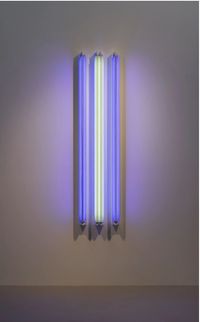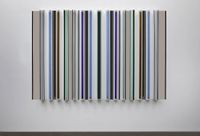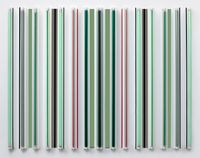A leading figure of the Light and Space movement, Californian artist Robert Irwin incorporates such materials as fluorescent lights, scrims, and acrylic panels into his sculptures and installations that prompt questions about the experience of seeing.
Read MoreBorn in Long Beach, California, Irwin studied in Los Angeles at Otis Art Institute (1948—1950), Jepson Art Institute (1951), and Chouinard Art Institute (1952—1954). By the time he held his first solo exhibition Robert Irwin at Felix Landau Gallery, Irwin was creating gestural Abstract Expressionist paintings that soon evolved into explorations of form and colour.
In 1958, the artist began showing with Ferus Gallery, then a destination for an emerging generation of artists in and outside Los Angeles including Larry Bell, Clyfford Still, Ed Ruscha, Roy Lichtenstein, Frank Stella, and Andy Warhol.
Irwin is closely associated with the Light and Space movement of the 1960s and 70s, in which a loosely affiliated group of West Coast artists sought to engage and challenge the viewer's perceptual encounter with works of art. Much like his like-minded contemporaries, including Bell, Mary Corse, James Turrell, and De Wain Valentine, Irwin experimented with methods of heightening the viewer's awareness of the artwork and its environment.
Among Irwin's recurring motifs were dots and lines, which he painted in minute scale to make the canvases appear blank from a distance. In the mid-1960s, the artist began working with discs to create wall installations such as Untitled (1966—1967): illuminated by multiple sources of light, a single concave aluminium disc cast overlapping shadows on the wall, while its otherwise hard edges seemingly faded into its surroundings.
Irwin has also employed scrims, installing panels of the translucent fabric across gallery spaces to blur the distinction between walls and ceiling, inside and outside. Scrim Veil—Black Rectangle—Natural Light, first presented on the fourth floor of the Whitney Museum of American Art, New York in 1977, was reinstalled at the museum in 2013.
Over the decades, Irwin has created artworks that are what he calls 'conditional' to a given site or a set of conditions in public spaces. Two Running Violet V Farms (1983), conceived for the University of California, San Diego, consist of two fence-like structures that weave through the eucalyptus groves on campus. Between 1999 and 2003, Irwin devised plans and interventions for Dia: Beacon, New York so that the galleries would be lit by natural light.
The experience of light continues to be significant to Irwin's work. Light and Space (2007), whose name references the Light and Space movement, comprises 115 fluorescent light tubes arranged into a cross-hatching pattern that envelops the viewer in light. Untitled (dawn to dusk), which was inaugurated in 2016 at the Chinati Foundation in Marfa, Texas, saw the artist install scrims to engulf one half of a wing in a former hospital in light and the other in dark.
In the 2010s, Irwin resumed working in his studio to create sculptural works, including those presented in his 2018 solo exhibition Sculpture/Configuration at Pace Gallery in New York. By intersecting translucent acrylic panels at various angles (Sculpture/Configuration 2T (2018)) or lining rows of fluorescent lights (Sonora #15 x 6' — Four Fold (2015)), Irwin continues to explore alluring depths and processes of perception.
Irwin exhibits internationally, with the more recent solo presentations including Robert Irwin: Unlights, Pace, New York (2020); Robert Irwin, Sprüth Magers, Berlin (2018); Robert Irwin: Site Determined, University Art Museum, California State University, Long Beach (2018); Robert Irwin: All the Rules Will Change, Hirshhorn Museum and Sculpture Garden, Washington D.C. (2016); Robert Irwin: 2 x 2 x 2 x 2, White Cube, London (2015); Robert Irwin, Excursus: Homage to the Square 3, Dia: Beacon, New York (2015); Scrim Veil — Black Rectangle — Natural Light (1977), Whitney Museum of American Art, New York (2013); Robert Irwin: Slant/Light/Volume, Walker Art Center, Minneapolis (2009); and Light and Space, White Cube, London (2008).
Selected group exhibitions include Minimalism: Space. Light. Object, National Gallery of Singapore (2018); Los Angeles: A Fiction, Musée d'art contemporain (MAC) Lyon (2017) Dansaekhwa & Minimalism, Blum & Poe, Los Angeles (2016); Paradise, Pace Gallery, New York (2013); Suprasensorial: Experiments in Light, Color and Space, The Geffen Contemporary at Museum of Contemporary Art, Los Angeles (2010); and Geometry of Motion 1920s/1970s, The Museum of Modern Art, New York (2008).
Sherry Paik | Ocula | 2021











